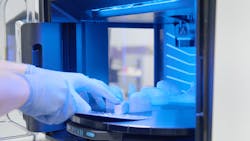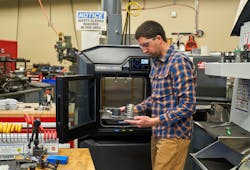When Yoav Zeif, CEO of additive manufacturing giant Stratasys announced his company’s intention to merge with rival company Desktop Metal, a significant portion of the pitch revolved around the advantages a merger would provide for scaling additive to the needs of the manufacturing world.
During his recent hour-long conversation with IndustryWeek, (read Part 1 here) Zeif argues that the definition of “scale” changes based on context. Scale in the automotive industry is different than aerospace, or consumer goods, or the additive manufacturing industry.
In Part 2 of our three-part interview series, we get to the heart of what scale means for Zeif and Stratasys and what it will take for additive manufacturing to become a larger part of the industrial landscape.
Does the Desktop Metal merger address scale?
IndustryWeek: Additive manufacturing is often too expensive and too slow for mass production. How does merging with rivals lower costs or boost speed?
Yoav Zeif: Today, additive manufacturing is only 0.1% of the total value of manufacturing output, only 10% of a percentage of a $14 trillion industry. And we are a bit less, around $12 billion, let’s say $14 billion industry. I think it won’t be practical to say that additive can capture 100% of manufacturing. But think about what happens if we capture 1% of manufacturing? We will be a $140 billion dollar industry.
Our aspiration is to address manufacturing where we have [an] indisputable advantage.
Opportunity No. 1 is short, medium runs to hundreds of thousands. And there, no doubt … we cost less than investing and then producing with traditional manufacturing.
No. 2 is what I call specific geometries or unique geometries, where we are saving in two to three different aspects. When you need to build, let’s say a robot, there are hundreds of parts there. We can reduce the number of parts significantly because we can do geometries that don’t require assembly.
Take connectors, for example, any connector that connects to your computer or high-end electronics. We know how to print the connector in one print because we have the material and we have the support material. Usually when you [manufacture] connectors in another way, with injection molding, you have different parts and then you assemble them.
Then the third [opportunity] is customization and personalization. … We know how to … print dentures for you with multi material and multicolor, exactly what you need. Today someone is printing the gingiva, printing the tooth, gluing them, testing them, you’ll go five times to your dentist to check if it’s okay because it’s based on [an] impression and then it’s corrected. We know how to print it once and put it in the mouth of the patient.
The fourth opportunity is supply chain. And last but not least is sustainability. We are more sustainable both because of the supply chain, we are shortening the supply chain, but more importantly because the environmental footprint of producing a part with additive is lower than with CNC.
So, our vision is not to be 100% of manufacturing. Our vision is to give the manufacturer clear advantages where we can reduce the cost, allowing them to produce parts that they couldn’t produce before, and making a more sustainable, much more flexible and less costly supply chain.
It will be a mistake, from our side, to look for applications where we are competing head-to-head with injection molding. There are parts that [industry] will only manufacture with injection molding. But there are, I don’t know if it’s 5% or 10% of overall manufacturing where we are solving problems that no one else can solve.
When Will Manufacturers Fully Adopt Additive?
IW: What mass-produced good has a high enough number of parts with specific geometries that it makes sense to move from traditional manufacturing methods to additive for their production?
YZ: That’s not the way we think about it. … We are very strong in aerospace and automotive. … We’re working with GM, with Ford, with Boeing, with Airbus, with Lockheed Martin … and we know our customers. We understand the number one thing that holds them back from adopting more additive manufacturing is practical education and allowables.An engineer that is coming out of university has the books, he understands exactly what he can and cannot do with each one of the traditional ways of manufacturing and materials. Additive does not have these books. We are investing a lot in creating this knowledge base because the moment in your mind that you are designing for additive, that’s the only way to gain those advantages.
We don’t think by part, or by material or by technology. We think by use cases. The use case could be tooling for automotive lines. Today, tooling is very complex. Takes a lot of months to get the tool. We have great success stories where we have the machines, they do the tooling, we [manufacture] it with composite, it’s working amazingly well.
Another use case is dentures. Another use case could be connectors. Another use case could be fashion. We know how to print on fabrics and on garments. So, we think about the use case and in that use case we show the customer that our solution is by far cheaper, cost effective, [provides] great part performance…
We are not trying to compete with injection molding. We are trying to give solutions when injection molding fails. … That’s the way I lead Stratasys. I don’t want to focus where I don’t have advantage. I focus only where I have clear advantage and can deliver high value to my customers. And this is super significant from our perspective.
IW: We had a conversation with General Motors recently, where they discussed using additive for tooling. But that is not mass production, not a use case at scale. Where is the practical demonstration that additive could do things other than casting molds, short batch parts? Where is the company we can point at that is currently using additive at scale?
YZ: What is scale for you? Here is the different perspective that we have. It will be a mistake for us as an industry to try to compete for a standard injection molding part in a Toyota Corolla. We’d be doomed to fail. This is not the advantage of additive manufacturing.
The advantage of additive manufacturing is in specific electric vehicles and we have great success stories in electric vehicles today. Hundreds of thousands of our parts in electric vehicles, where the part and the geometry … save money [for] the manufacturer or the producer not because he checked exactly how many cents the cubic centimeters of polymer cost, [but] because the specific parts solve a problem within the design or the weight that you cannot do with the other [manufacturing methods].
I work with so many companies … that are producing hundreds or thousands of machines a year. This is scale, because there are many small businesses like this in the world. They are investing in molds and tooling, but they can print and be much more flexible. And when you multiply one manufacturer like Stratasys, we are selling almost $700 million a year printing parts [for customers] because it doesn’t make sense to invest in the infrastructure and the tooling for a line of products that sell 700 machines a year.
If you multiply [this] by hundreds of thousands of companies like Stratasys, we are good. This is scale for me. It’s a different definition than the scale you mentioned.





